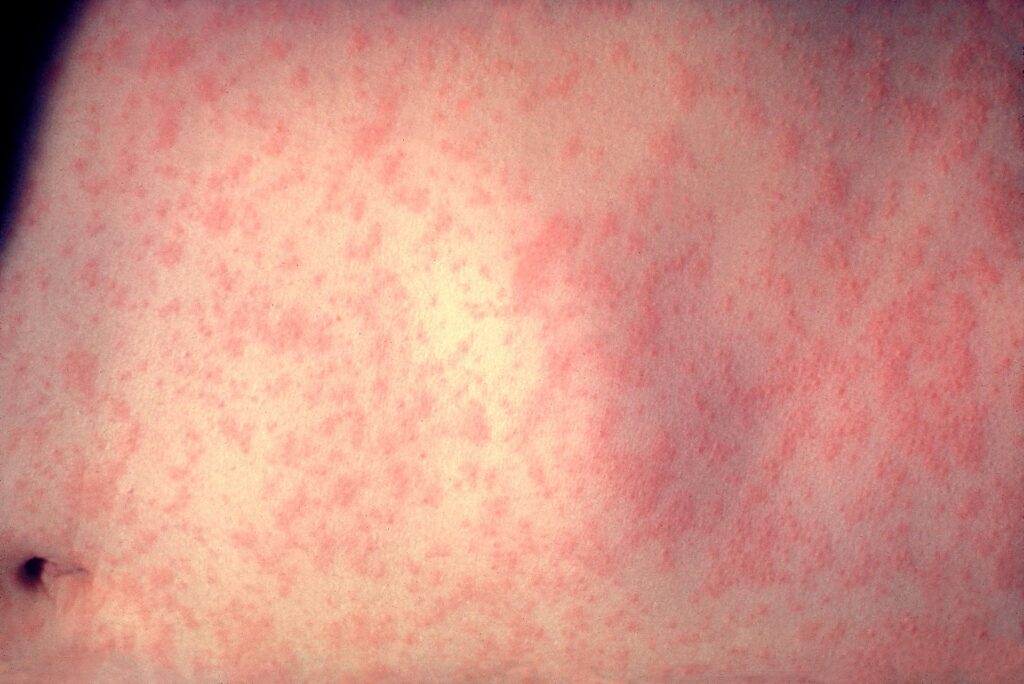What is it?
Measles is an extremely contagious vaccine preventable disease known for its effect on children. It is so infectious, that one person can infect up to 18 others! The virus can float in the air for up to four hours, even if the infectious person has left the area. Of vaccine-preventable diseases, measles is one of the leading causes of death (Kabra & Lodha, 2013). Upon infection, symptoms begin about 10-14 days and include a four-day fever, the “three C’s” (cough, coryza (inflammation of the nose mucous membrane), conjunctivitis (red eyes)), and a maculopapular rash which look like red splotches across the skin, as seen in figure 1 (Biesbroeck & Sidbury, 2013).

Like COVID-19, the measles virus evolved from a virus found in animals, specifically a virus called rinderpest. As history went on, measles became an endemic disease much like polio, meaning that it was common within the population and people built up a natural resistance to it and it was simply a part of life. However, when introduced into populations that lacked any immunity to measles, it was disastrous. This is exactly what occurred in Cuba in 1529, and it killed two out of every three indigenous people who literally just survived an outbreak of smallpox! Measles was estimated to kill around 200 million people worldwide between 1855 and 2005 (McNeill, n.d.). Often, measles kills indirectly via superinfection – when another pathogen takes the opportunity to infect the measles-ridden person. Most commonly, pneumonia accounts for 56-86% of measles-related deaths (Di Pietrantonj et al., 2021). You can learn more about the bacterium that causes pneumonia here.
How did we Fight it?
Preventing measles was incredibly difficult due to its extremely high infectiousness. Prior to 1963, practically all children got measles with around 3 to 4 million people in the USA infected each year (History of Measles | CDC, n.d.). It was very difficult to control, prevent, and treat measles up until the mid-1900s when better medical treatments became available (Najera, 2019). Some groups including the severely malnourished and young children are given vitamin A due to its ability to act as an immunomodulator that boosts the antibody response to measles, decreasing risk of serious complications (Bester, 2016).
Vaccines
The measles vaccine is exceptionally safe and effective at prevention. Usually, the measles vaccine is delivered with other vaccines. Through vaccination, an 80% decrease in deaths from measles from 2000 to 2017 occurred with 2.6 million people dying from measles in 1980 and just 73,000 by 2014 (Measles, n.d.). However, a worrying trend has started as rates of the disease and deaths increased from 2017 to 2019 because of less immunization. This is likely because the measles vaccine has been subject to significant misinformation throughout the years, all starting with a false study published my Wakefield in the 1990s, which you can read about here in our case study module.
The most common vaccine is called the MMR vaccine and given three times to immunize against not just measles but also mumps and rubella. The first dose is given at 12 months old when the infant has a more mature immune system, then the second dose is given at age five. The first dose is 95% effective while the second dose is 99% effective in providing immunity against measles (Bester, 2016).
References
Bester, J. C. (2016). Measles and Measles Vaccination: A Review. JAMA Pediatrics, 170(12), 1209–1215. https://doi.org/10.1001/JAMAPEDIATRICS.2016.1787
Biesbroeck, L., & Sidbury, R. (2013). Viral exanthems: an update. Dermatologic Therapy, 26(6), 433–438. https://doi.org/10.1111/DTH.12107
Details – Public Health Image Library(PHIL). (n.d.). Retrieved August 27, 2023, from https://phil.cdc.gov/details.aspx?pid=3168
Di Pietrantonj, C., Rivetti, A., Marchione, P., Debalini, M. G., & Demicheli, V. (2021). Vaccines for measles, mumps, rubella, and varicella in children. The Cochrane Database of Systematic Reviews, 2021(11). https://doi.org/10.1002/14651858.CD004407.PUB5
History of Measles | CDC. (n.d.). Retrieved August 27, 2023, from https://www.cdc.gov/measles/about/history.html
Kabra, S. K., & Lodha, R. (2013). Antibiotics for preventing complications in children with measles. The Cochrane Database of Systematic Reviews, 2013(8). https://doi.org/10.1002/14651858.CD001477.PUB4
McNeill, W. (n.d.). Bird Flu – “Most and probably all of the distinctive infectious diseases of civilization have been transferred to human populations from animal herds.” Retrieved August 27, 2023, from https://web.archive.org/web/20091003164005/http://www.birdflubook.com/a.php?id=40
Measles. (n.d.). Retrieved August 27, 2023, from https://www.who.int/news-room/fact-sheets/detail/measles
Najera, R. (2019). A Brief History of Measles | History of Vaccines. https://historyofvaccines.org/blog/a-brief-history-of-measles